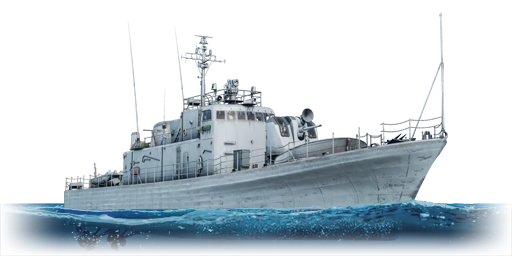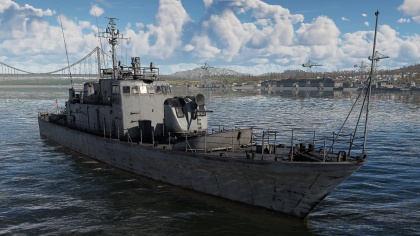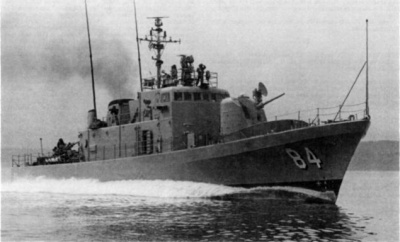Difference between revisions of "USS Asheville"
Bonisducks (talk | contribs) (→History) (Tag: Visual edit) |
Bonisducks (talk | contribs) (→Works Cited: Done History and References.) (Tag: Visual edit) |
||
| Line 108: | Line 108: | ||
* ''links to approximate analogues of other nations and research trees.'' | * ''links to approximate analogues of other nations and research trees.'' | ||
| − | == External links == | + | == External links ==<!-- Paste links to sources and external resources, such as: |
| − | |||
| − | + | topic on the official game forum; | |
| − | + | encyclopedia page on ship; --> | |
| + | === References === | ||
| + | <references /> | ||
=== Works Cited === | === Works Cited === | ||
Revision as of 20:04, 19 November 2020
Contents
Description
The Asheville-class, USS Asheville (PGM-84) is a rank IV American motor gun boat
with a battle rating of 3.3 (AB/RB/SB). It was introduced in Update 1.79 "Project X" as part of the fleet closed beta test.
General info
Survivability and armour
Talk about the vehicle's armour. Note the most well-defended and most vulnerable zones, e.g. the ammo magazine. Evaluate the composition of components and assemblies responsible for movement and manoeuvrability. Evaluate the survivability of the primary and secondary armament separately. Don't forget to mention the size of the crew, which plays an important role in fleet mechanics. Tips for preserving survivability should be saved for the "Use in battle" section.
If necessary, use a graphic template to show the most well-protected or most vulnerable points in the armour.
Mobility
Write about the ship’s mobility. Evaluate its power and manoeuvrability, rudder rerouting speed, stopping speed at full tilt, with its maximum forward speed and reverse speed.
Armament
Primary armament
Provide information about the characteristics of the primary armament. Evaluate their efficacy in battle based on their reload speed, ballistics and the capacity of their shells.
Broadly describe the ammunition available for the primary armament, and provide recommendations on how to use it and which ammunition to choose.
Secondary armament
Some ships are fitted with weapons of various calibres. Secondary armament is defined by the weapon chosen with the control Select secondary weapon. Evaluate the secondary armament and give advice on how to use them. Describe the ammunition available for the secondary armament. Provide recommendations on how to use them and which ammunition to choose. Remember that anti-air armament, even heavy calibre weapons, belong in the next section.
Anti-aircraft armament
An important part of the ship’s armament responsible for air raid defence. Anti-aircraft armament is defined by the weapon chosen with the control Select anti-aircraft weapons. Talk about the ship’s anti-air cannons and machine guns, the number of guns and their positions, their effective range, and about their overall effectiveness – including against surface targets.
Usage in battles
Describe the technique of using this ship, the characteristics of her use in a team and tips on strategy. Abstain from writing an entire guide – don’t get try to provide a single point of view, but give the reader food for thought. Talk about the most dangerous opponents for this vehicle and provide recommendations on fighting them. If necessary, note the specifics of playing with this vehicle in various modes (AB, RB, SB).
Modules
| Tier | Seakeeping | Unsinkability | Firepower | |||
|---|---|---|---|---|---|---|
| I | Dry-Docking | Tool Set | 76 mm APHE | 40 mm HE clips | Anti-Air Armament Targeting | |
| II | Rudder Replacement | Fire Protection System | Smokescreen | 76 mm HE-VT | 40 mm AP clips | Auxiliary Armament Targeting |
| III | Propeller Replacement | Improved Rangefinder | Primary Armament Targeting | |||
| IV | Engine Maintenance | New Pumps | ||||
Pros and cons
Summarize and briefly evaluate the vehicle in terms of its characteristics and combat effectiveness. Mark its pros and cons in the bulleted list. Try not to use more than 6 points for each of the characteristics. Avoid using categorical definitions such as "bad", "good" and the like - they have a substitution in the form of softer "inadequate", "effective".
Pros:
Cons:
History
USS Asheville (PGM-84) was the lead ship of the Asheville class, a series of seventeen patrol gunboats built for the US Navy. Completed in 1967, she saw service in the Vietnam war as a blockade ship and patrol vessel. Following the end of hostilities in Vietnam, Asheville returned to the United States as a training vessel; she would eventually serve as a training ship in the Great Lakes, and was transferred in 1977 to the Massachusetts Maritime Academy.[1][2]
Design and construction
The Asheville was designed as a small gunboat, and thus displaced 240 tons. She carried an armament of a single 3-inch (76 mm) gun at the bow, a 40 mm Bofors gun at the rear and two 12.7 mm heavy machine guns.[2] Being a patrol boat, she had a small crew complement of just 37. Equipped with a CODOG (combined gas and diesel propulsion) system, she could make a top speed of 40 knots (74 km/h).[2] Asheville was laid down on April 15th 1964 by the Tacoma boat-building company. She was launched on May 1st 1965, and commissioned on April 1st 1967.[2]
Operational History
Following her commissioning and shakedown cruise, the Asheville was homeported at San Diego, California. She departed the port in April and sailed to Hawaii, then Guam, then her final destination of South Vietnam to serve in the Vietnam war.[1] She saw eight years of service in the Asian and Pacific theatre, though large parts were spent in port due to a shortage of men and engine parts to service her rather unreliable propulsion system. She frequently conducted blockade missions off of the Vietnamese coast, in an effort to prevent the flow of arms and supplies to the communist rebels in South Vietnam.[1][2]
In December of 1972, the United States stopped its military involvement in Vietnam; this halted Asheville's combat activities. She remained in the Western Pacific for an additional two years, visiting a variety of Pacific ports. She then sailed for Chicago via the Panama canal, and arrived at her final destination in December of 1974. She served as a training vessel on the Great lakes between 1974 and 1977;[1] she was decommissioned on January 31st 1977 and simultaneously stricken from the navy list. She was then given to the Maine Maritime academy as a training vessel; her name is now taken by USS Asheville (SSN-758), a Los Angeles-class nuclear submarine.[1]
Media
An excellent addition to the article will be video guides, as well as screenshots from the game and photos.
See also
Links to the articles on the War Thunder Wiki that you think will be useful for the reader, for example:
- reference to the series of the ship;
- links to approximate analogues of other nations and research trees.
External links
References
Works Cited
- Ashe, W., & Holland, R. (2006). Asheville, USS. Retrieved November 19, 2020, from https://ncpedia.org/asheville-uss
- Priolo, G. (1996). NavSource Online:Motor Gunboat/Patrol Gunboat Photo Archive. Retrieved November 19, 2020, from http://www.navsource.org/archives/12/11084.htm
| Tacoma Boatbuilding Co. | |
|---|---|
| Motor Gunboats (PGM) | |
| Asheville-class | USS Asheville · USS Douglas |
| USA boats | |
|---|---|
| Motor torpedo boats | PT-3 · PT-6 · PT-20 · PT-71 · PT-103 · PT-109 · PT-174 |
| PT-200 · PT-314 · Thunderbolt (PT-556) · PT-565 · PT-658 · PT-810 · PT-811 · PT-812 | |
| Motor gun boats | Kim Qui · LCS(L)(3) · PT-59 · PTF-7 · USS Candid · USS Asheville · USS Douglas · USS Tucumcari · USS Cyclone |
| Armoured gun boats | LCM(6) Zippo |






